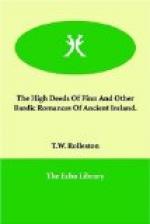Then, as to all good landscape lovers, the beasts, birds, and insects of Nature were dear to these ancient people. One of the things Finn most cared for was not only his hounds, but the “blackbird singing on Letterlee”; and his song, on page 114, in the praise of May, tells us how keen was his observant eye for animal life and how much it delighted him. The same minute realisation of natural objects is illustrated in this book when King Iubdan explains to the servant the different characteristics of the trees of the forest, and the mystic elements that abide in them. It was a habit, even of Teutonic poets, to tell of the various trees and their uses in verse, and Spenser and Drayton have both done it in later times. But few of them have added, as the Irish story does, a spiritual element to their description, and made us think of malign or beneficent elements attached to them. The woodbine, and this is a strange fancy, is the king of the woods. The rowan is the tree of the magicians, and its berries are for poets. The bramble is inimical to man, the alder is full of witchcraft, and the elder is the wood of the horses of the fairies. Into every tree a spiritual power is infused; and the good lords of the forest are loved of men and birds and bees.
Thus the Irish love of nature led them to spiritualise, in another way than mythical, certain things in nature, and afterwards to humanise, up to a certain point, the noble implements wrought by human skill out of natural materials. And this is another element in all these stories, as it is in the folk-lore also of other lands. In the tale of the Sons of Turenn, the stones of the wayside tell to Lugh the story of the death of his father Kian, and the boat of Mananan, indwelt by a spirit, flies hither and thither over the seas, obeying the commands, even the thought, of its steersman. The soul of some famed spears is so hot for slaughter that, when it is not being used in battle, its point must stand in a bath of blood or of drowsy herbs, lest it should slay the host. The swords murmur and hiss and cry out for the battle; the shield of the hero hums louder and louder, vibrating for the encouragement of the warrior. Even the wheels of Cuchulain’s chariot roar as they whirl into the fight. This partial life given to the weapons of war is not specially Celtic. Indeed, it is more common in Teutonic than in Celtic legend, and it seems probable that it was owing to the Norsemen that it was established in the Hero tales of Ireland.




